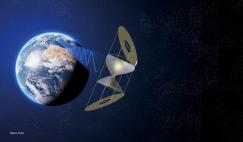Spanish aerospace company PLD Space made history on 7 October 2023 by successfully launching the first private European rocket, the suborbital MIURA 1, from El Arenosillo Experimentation Centre (CEDEA) in southwest Spain. For the company this groundbreaking event was a stepping stone to accelerate the technological advancement of their MIURA 5 rocket with the ultimate goal of launching Europe’s first recoverable launch vehicle. Raúl Verdú, Chief Business Development Officer for PLD Space, spoke to Daniel Smith for ROOM.
 Raul Verdu
Raul Verdu
Congratulations on the launch in October [2023]. What did this milestone mean for you as a company and as individuals?
This launch of MIURA 1 marked over 12 years of relentless effort and yet it is just the start of our journey. First of all, the test flight yielded valuable data, enabling us to validate crucial design elements and technologies that will underpin the development of our MIURA 5 orbital launcher.
But this launch also establishes PLD Space as a frontrunner in the European space race. We ventured into space, fueled more by determination than resources, yet we triumphed and the team’s elation was tangible. Indeed, the mission’s success was a collective accomplishment, encompassing our investors, partners and suppliers. For me personally, the launch was like winning the European Champions League with a second division football team!
 Artist’s impression of the MIURA 5 on the launch pad in Kourou, French Guiana. The inaugural launch of could take place by the end of 2025.
Artist’s impression of the MIURA 5 on the launch pad in Kourou, French Guiana. The inaugural launch of could take place by the end of 2025.
The success of a test flight like this is gauged by the insights we gain, insights that enhance our future reliability and success rate. We developed MIURA 1 as a stepping stone to accelerate the technological advancement of MIURA 5. Looking to the immediate future, our team is poised to progress rapidly towards the inaugural flight of MIURA 5, which is our ultimate goal.
At present, over 90 percent of the PLD Space team is dedicated to developing MIURA 5. Its maiden launch is scheduled for 2025 from the European spaceport in Kourou, French Guiana, with commercial operations set to begin in 2026.
Of course, we celebrate what we achieved in MIURA 1, because to successfully launch a rocket with an accuracy of 500 m on a maiden flight is almost unheard of. We are also very proud to validate our methodology and our vision, which we have done for just 30 million Euro.
What have you learnt as a team in accomplishing this feat?
We ventured into space, fueled more by determination than resources, yet we triumphed
Fundamentally, we have learnt how to develop a launcher company. It is very complicated because there are so many things – research and development challenges, financial challenges, human-resource challenges… and then you have logistics, institutional issues and license submissions. There are so many things that you need to control in a very precise way for months just to launch a rocket. In fact, there is nothing simple about a rocket, so we are really proud of what we have learned about all aspects in the development of our launcher company.
Importantly, our view today is that, if we had decided to go directly to an orbital vehicle, we are sure that we would have failed, because while validating many aspects we can use directly for MIURA 5, we also learned many things that we don’t want to do for MIURA 5.
 Enhanced manufacturing capabilities for MIURA 5 full scale production.
Enhanced manufacturing capabilities for MIURA 5 full scale production.
It’s taken you a number of years to get to this position, as you said. Tell us a little bit about the history of PLD Space.
We founded the company as space enthusiasts. We were at university, working in a kind of rocketry association during the weekends and spent much of our free time doing rocketry.
In the United States, there are many launcher companies with a good pedigree and facilities but the landscape is not the same in Europe. There was nothing at the base level, so we tried to convince our national delegation to give us a small contract to develop a little rocket engine demonstration because, for us, propulsion is the key. If you don’t have an engine, you have nothing. We won a national contract of one million Euros in 2015, which was a kind of record at the national level in fundraising for the space sector.
We started a company, but people were saying it’s impossible to raise the money, it’s impossible to develop an engine. Then, when we developed the engine, they said: okay you developed an engine but it’s impossible to develop the full vehicle. We developed the full vehicle and people said you’ll never launch it… but we launched it!
And now, for us, the goal is an orbital launcher, which of course we are told is also impossible! You know, for us, this is the motivation – proving that the impossible is possible.
How many people do you have at the company at the moment and what are you plans for growth?
Today, we have 164 full-time employees but we have a very aggressive growth plan and intend to have around 270 or so employees by the end of the year. We currently have about 100 positions available on our website.
We are in the process of moving all our engineers for MIURA 1 to MIURA 5 and enlarging our production capacity, as we move from the research and development phase to commercial production. We hope to manufacture something like 30 rockets per year, so we’re preparing for that capacity.
How is your offering different from what is out there in the market at the moment?
We developed MIURA 1 as a stepping stone to accelerate the technological advancement of MIURA 5
Our vision was not to try to reinvent the wheel because customers are asking for reliability, good prices and availability, so you just need to develop the rocket in a proper way and to ensure good orbital accuracy and things like that.
The innovation in our rocket is that it’s a green solution, using bio-kerosene, which we have developed in collaboration with Repsol, the national energy company in Spain. It’s similar in terms of chemistry - it just means using oil from burger shop fryers and that kind of thing - so we don’t need to change anything in the rocket. In terms of materials, we are using aluminium, which has infinite cycles of being recyclable. All of our mechanisms have a high-level requirement not to eject any small parts, so as not to generate more space debris, and our second stage is capable of deorbiting from low Earth orbit (LEO). These things aren’t mandatory today but at some point in the future they will be, and we want to be prepared.
Moreover, space sustainability is a very important topic for us right now. This includes not only sustainability in terms of the environment - for example, we use rainwater to deluge our pad during engine tests - but also the financial sustainability of the business.
Another differentiator is that we are the most advanced in terms of reusability. We started to develop our reusable technology in 2017 with a European Space Agency programme, and we are now the most advanced. Not all small launchers are reusable, so I think this is the way forward.
What about the key challenges for future development?
For us, it’s all about scaling up, increasing the size of the vehicle from 12 m long and 0.7 m in diameter to 35.7 m long and 2 m in diameter. Size is one of the challenges.
One thing that we demonstrated on MIURA 1 was the staging mechanism. It’s a very tricky system, because - for MIURA 5 - we need to separate the stages and start up an engine at height, so that’s another challenge. And we need to start to learn to accommodate the payloads of our customers and develop reliable release mechanisms.
Now that you’ve proved that you can do suborbital, are you intending to monetise that by offering microgravity or component test missions?
We noted that business opportunity, but to be honest it’s a small opportunity, and we can earn more launching satellites into orbit than doing microgravity research. We may try to do two or three launches a year just for research, but we don’t see a huge business in that.
 MIURA 1 on the launch pad at the El Arenosillo launch site in Huelva Spain prior to launch on 7 October 2023.
MIURA 1 on the launch pad at the El Arenosillo launch site in Huelva Spain prior to launch on 7 October 2023.
When will commercial launches begin and are you planning to use the El Arenosillo launch site in Huelva exclusively or are you looking around?
Huelva is a military base in southwestern Spain, so it’s very good for suborbital tests but it’s not a spaceport. We can do all the acceptance and qualification testing there, but our first commercial mission will be from Kourou in French Guiana (following an agreement we signed with the French space agency CNES last summer).
Would you be one of the first commercial providers to fly from Kourou?
We developed the full vehicle and people said you’ll never launch it… but we launched it!
For us it’s not a race to be the first, it’s a race to be the most reliable with the proper price. The market will put us in our place in five years, so we are just going to work to try to be the best solution. But yes, we want to compete - we love to compete to be honest - and there are so many promising projects, not only in Europe but also in the US, India, China, South Korea, Japan and so on. I think it’s good because it promotes new missions.
But what about timelines? That’s what people always want to know.
I think we are a couple of years away from our maiden orbital flight. We hope to be ready to launch the rocket by the end of 2025, but this is a complicated business and rocket development is never easy. That said, we are one of the more resilient companies in Europe and know how to face the difficulties. The project may be super-complex, but we always deliver what we promise.
 PLD Space made history after successfully completing the launch of a first private European rocket, MIURA 1. The MIURA SN1 Test Flight lasted 306 seconds, reaching an apogee of 46 kilometres high, concluding with the launcher’s splashdown in the Atlantic Ocean, followed by recovery of the vehicle.
PLD Space made history after successfully completing the launch of a first private European rocket, MIURA 1. The MIURA SN1 Test Flight lasted 306 seconds, reaching an apogee of 46 kilometres high, concluding with the launcher’s splashdown in the Atlantic Ocean, followed by recovery of the vehicle.
About the interviewee
Raúl Verdú is co-founder and Chief Business Development Officer of PLD Space with training in Industrial Engineering and more than 10 years of experience. His capabilities range from team management to the execution of industrial R&D projects from concept to design, legalisation and execution. Together with CEO Raúl Torres, he has raised more than €65 million in financing for the development of the MIURA 5 launcher programme. He was awarded the Spanish Scientific Association Plaque of Honour and was recognised by the Kairos Society as one of the 100 most influential entrepreneurs in the world.














